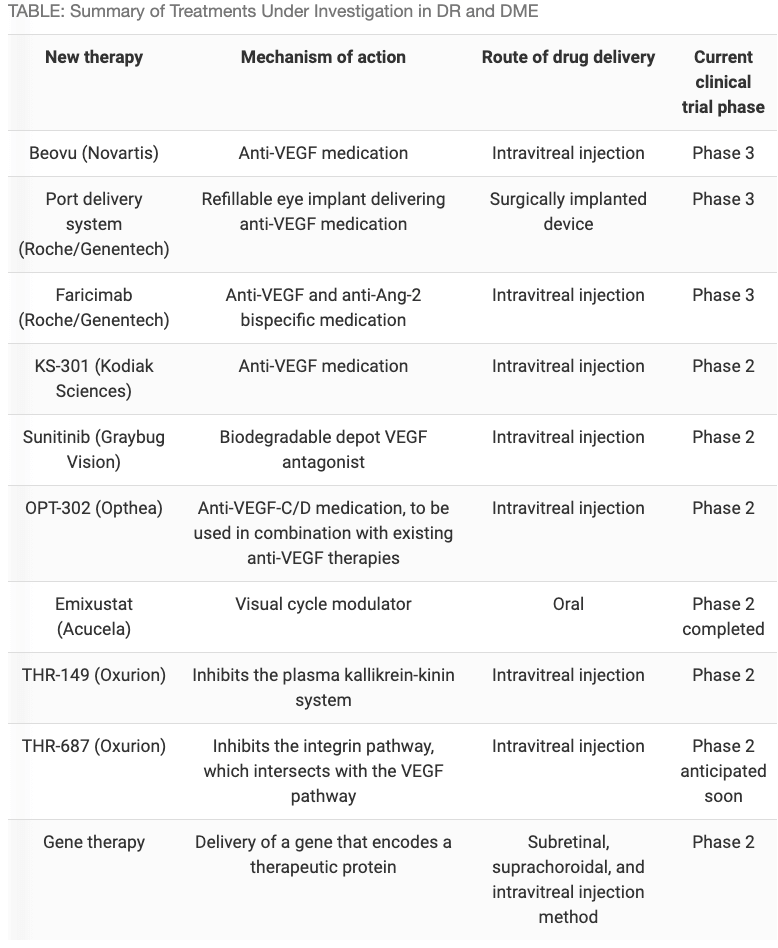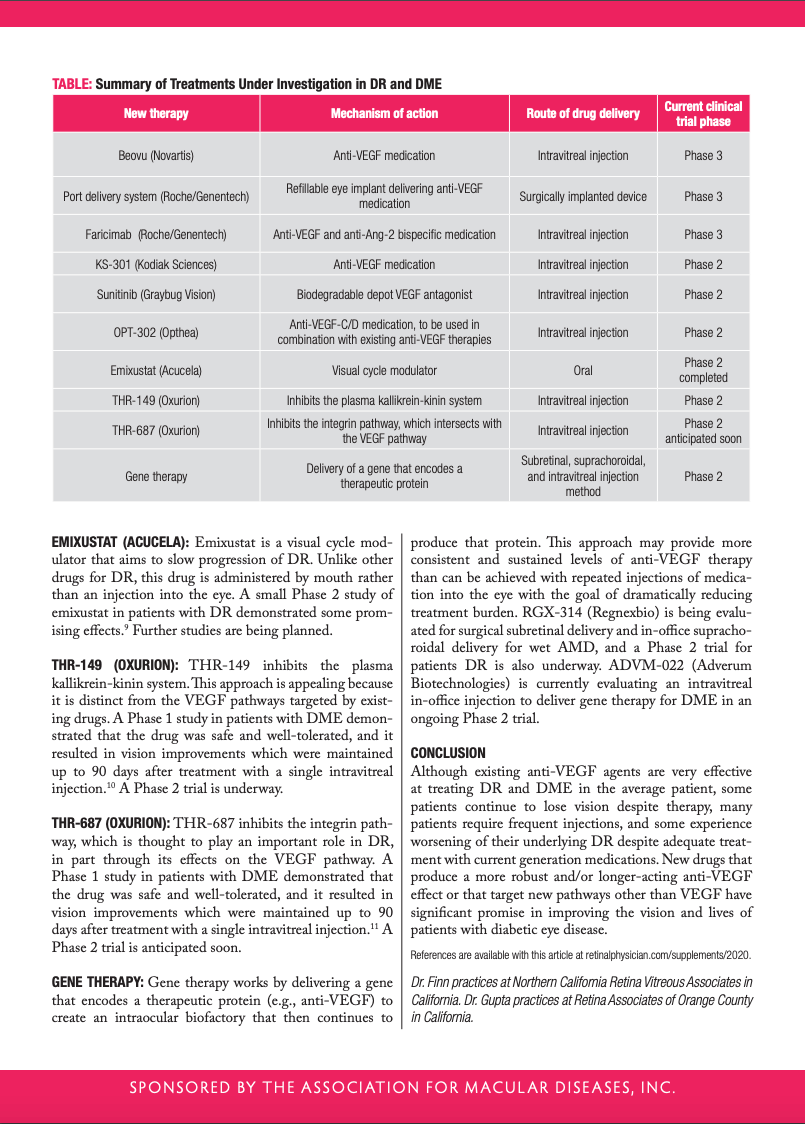Current drug treatments for both diabetic retinopathy (DR) and diabetic macular edema (DME) are aimed at inhibiting a molecule called vascular endothelial growth factor (VEGF) or employ steroids to broadly treat inflammatory mediators present in DME and DR. The anti-VEGF medications currently include Avastin, Lucentis and Eylea, while the steroid-based treatments include triamcinolone acetonide, Ozurdex, and Illuvien. Many patients need frequent injections of these drugs, and some experience worsening of their vision or their DR despite treatment with these agents. Given these limitations, clinical trials are underway to evaluate new therapies that could provide therapeutic effect for a longer duration and/or target other pathways. Here we summarize several such therapies under investigation, primarily focusing on late-stage clinical trials (Phases 2 & 3).
BEOVU (NOVARTIS): Beovu (brolocizumab) is an antibody fragment inhibiting VEGF. The medication’s smaller size and higher molar concentration enable it to have a strong effect in treating fluid and potentially longer duration of action. Data from a Phase 3 trial evaluating the medication for wet age-related macular degeneration (AMD) showed more than half of patients were able to continue on a 3-month dosing regimen with Beovu through 1 year.1 However, there are safety concerns with this medication due to intraocular inflammation and occlusive retinal vasculitis occurring in some patients receiving the medication for AMD.2
PORT DELIVERY SYSTEM (GENENTECH): This treatment consists of a small refillable device that stores and continuously releases anti-VEGF medication into the eye by diffusion, taking the place of frequent injections. The device is surgically implanted into the wall of the eye. The tiny implant can then be refilled in the office with medication as needed. Current studies evaluating patients with wet AMD showed the majority of patients could go 6 months before needing retreatment.3 Enrollment for Phase 3 clinical trials evaluating this device for use in patients with DME and DR are ongoing.
FARICIMAB (GENENTECH): Faricimab inhibits two pathways leading to abnormal blood vessel growth and leakage: It binds and inactivates a molecule called angiopoietin-2 (Ang-2) in addition to the VEGF molecule that current medications inhibit. The goal of this dual inhibition is to potentially improve outcomes and durability of the treatment. A Phase 2 trial comparing faricimab with Lucentis showed improved visual acuity gains with faricimab as well as improvements in the severity of DR. Also, this study showed that many patients receiving faricimab could go up to 12 or even 16 weeks before needing retreatment, decreasing frequent treatment burden for these patients.4 Two Phase 3 clinical trials evaluating faricimab for DME are currently underway.
KSI-301 (KODIAK SCIENCES): KSI-301 is a specially formulated anti-VEGF drug called an antibody polymer conjugate. The medication is expected to stick around the eye for a longer time and deliver a greater dose of medication with one injection. Early-stage studies of the medication showed that over 70% of patients with DME were able to go more than 4 months without needing retreatment after an initial three loading doses.5 Larger trials evaluating the drug for use in DME and DR are currently underway.
SUNITINIB (GRAYBUG VISION): Sunitinib is a specially formulated depot medication that slowly dissolves over time in the eye. This medication is a tyrosine kinase inhibitor that blocks VEGF receptors. After the medication is injected, its small particles aggregate or stick together and slowly release over time, allowing for the possibility of an extended treatment effect.6 Early stage trials showed the medication could last up to 6 months in the majority of patients with wet AMD.7The medication is currently in a Phase 2 trial for patients with DME.
OPT-302 (OPTHEA): OPT-302 inhibits VEGF-C and VEGF-D and is designed to be used in combination with the existing therapies, which target VEGF-A or VEGF-A and B. The rationale is that blocking additional VEGF family members will yield a more potent and longer-lasting anti-VEGF effect. Preliminary data from an ongoing Phase 2a trial suggests that combination therapy with Eylea and intravitreal OPT-302 yields superior vision outcomes than treatment with Eylea alone in eyes with DME.8 Phase 3 trials may be performed in the future.

EMIXUSTAT (ACUCELA): Emixustat is a visual cycle modulator that aims to slow progression of DR. Unlike other drugs for DR, this drug is administered by mouth rather than an injection into the eye. A small Phase 2 study of emixustat in patients with DR demonstrated some promising effects.9 Further studies are being planned.
THR-149 (OXURION): THR-149 inhibits the plasma kallikrein-kinin system. This approach is appealing because it is distinct from the VEGF pathways targeted by existing drugs. A Phase 1 study in patients with DME demonstrated that the drug was safe and well-tolerated, and it resulted in vision improvements which were maintained up to 90 days after treatment with a single intravitreal injection.10 A Phase 2 trial is underway.
THR-687 (OXURION): THR-687 inhibits the integrin pathway, which is thought to play an important role in DR, in part through its effects on the VEGF pathway. A Phase 1 study in patients with DME demonstrated that the drug was safe and well-tolerated, and it resulted in vision improvements which were maintained up to 90 days after treatment with a single intravitreal injection.11 A Phase 2 trial is anticipated soon.
GENE THERAPY: Gene therapy works by delivering a gene that encodes a therapeutic protein (e.g., anti-VEGF) to create an intraocular biofactory that then continues to produce that protein. This approach may provide more consistent and sustained levels of anti-VEGF therapy than can be achieved with repeated injections of medication into the eye with the goal of dramatically reducing treatment burden. RGX-314 (Regnexbio) is being evaluated for surgical subretinal delivery and in-office suprachoroidal delivery for wet AMD, and a Phase 2 trial for patients DR is also underway. ADVM-022 (Adverum Biotechnologies) is currently evaluating an intravitreal in-office injection to deliver gene therapy for DME in an ongoing Phase 2 trial.
CONCLUSION
Although existing anti-VEGF agents are very effective at treating DR and DME in the average patient, some patients continue to lose vision despite therapy, many patients require frequent injections, and some experience worsening of their underlying DR despite adequate treatment with current generation medications. New drugs that produce a more robust and/or longer-acting anti-VEGF effect or that target new pathways other than VEGF have significant promise in improving the vision and lives of patients with diabetic eye disease.


- Novartis. Available at: https://www.novartis.com/
news/media-releases/novartis- reports-positive-topline- results-from-first-phase-iii- trial-beovu-versus- aflibercept-patients-diabetic- macular-edema-dme . Accessed Sep. 14, 2020. - Baumal CR, et al. Ophthalmology. 2020;127(
10):1345-1359. - Campochiaro PA, et al. Ophthalmology. 2019;126(8)
:1141-1154. - Sahni J, et al. Ophthalmology. 2019;126(8)
:1155-1170. - Eyewire News. Available at: https://eyewire.news/
articles/kodiak-sciences- announces-data-from-ongoing- phase-1b-study-of-ksi-301-in- patients-with-wet-amd-dme-and- rvo/ . Accessed Sep. 13, 2020. - Tsujinaka H, et al. Nature Communications. 2020;11(1):1-
13. - Graybug Vision. Available at: https://www.graybug.
vision/graybug-vision- initiates-phase-2b-altissimo- clinical-trial-of-gb-102-in- patients-with-wet-age-related- macular-degeneration/ . Accessed Sep. 14, 2020. - GlobeNewswire. Available at: https://www.globenewswire.
com/news-release/2020/07/27/ 2067722/0/en/Opthea-Reports- New-Data-of-OPT-302-in- Diabetic-Macular-Edema-at-the- 2020-Annual-Meeting-of-the- American-Society-of-Retina- Specialists.html . Accessed Sep. 14, 2020. - Kubota Holdings. Available at: https://www.
kubotaholdings.co.jp/en/ pipeline/development/pdr/ index.html . Accessed Sep. 14, 2020. - Healio. Available at: https://www.healio.com/
news/ophthalmology/20190909/ oxurions-plasma-kallikrein- inhibitor-shows-positive- phase-1-study-results . Accessed Sep. 14, 2020. - Healio. Available at: https://www.healio.com/
news/ophthalmology/20200213/ phase-1-study-of-thr687-for- dme-shows-improvement-in- vision . Accessed Sep. 14, 2020.







